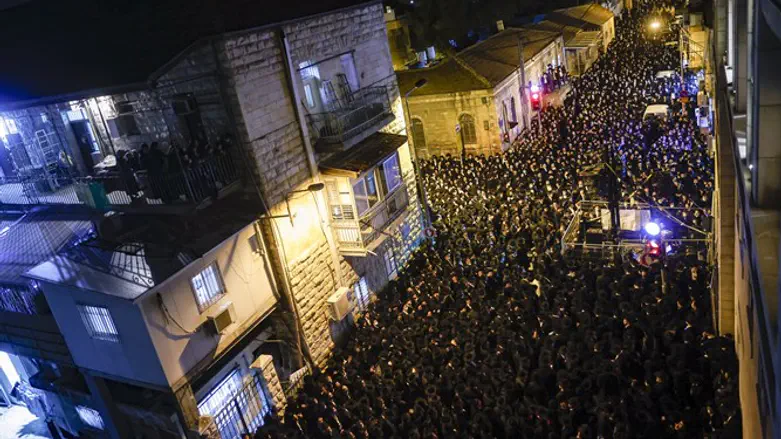
Shas Party Chairman and Interior Minister Aryeh Deri today said the infection coefficient among the haredi sector is lower than that in the general sector, in light of the fact that the majority of the haredi public adheres to Health Ministry guidelines.
"Look at the table and stop already with the wild incitement, the lies, and the hatred of the haredim. The infection coefficient in the general sector, the R, passed 1. For the haredim, it dropped to 0.86. And experts say it shows more than anything who follows the guidelines, and who less. The majority of the haredi public is meticulous and observant. So enough with the incitement,'' Deri said.
Hadassah Hospital in Jerusalem COVID ward head Prof. Dror Mevorach presented an alarming forecast this morning following the mass gatherings in Jerusalem, and explained their impact on the rate of morbidity.
Mevorach said: "I see how it translates to patients and how patients translate to critically ill and how 20 percent of critically ill patients come to intensive care and, sadly, die. I don't have to be a prophet to know there are clear statistics and it is a great pity.
"The funeral started with many people in a closed room and ended with many people in a closed room without masks. Even in the open air there was very high density, lack of masks, for long hours. I will not say that I am medically enthusiastic about the demonstrations at Balfour, but I think what happened yesterday was much more crowded and completely careless."
He described the morbidity situation at the hospital: "The population is becoming more and more haredi, the secular remain more or less similar, but the population is becoming more and more haredi in the last month. The spread of the plague in the haredi population is at least twice that of the secular population, certainly in Jerusalem but also throughout the country." He added: "We have a lot of patients, we do not see a decrease, unfortunately neither in the number of patients nor in the number of serious patients. There have always been young patients, make no mistake, but there may be a few more. This isn't yet a situation where I'm not seeing patients aged 60 and over, absolutely not, this is not the case. There are also young people aged 20-50; unfortunately the effect of the vaccines is not dramatic."
He said the vaccines are coming in slowly and gradually, but too much hope is being built on them: "The maximum effect of the vaccines will take some more time, it's not immediate."
Mevorach explained why there has not yet been a decrease in the disease's scope: "There is a compound of 3 factors here mainly - one, this lockdown is not the lockdown like we had in the first and second lockdown. The second is that the British mutation has very great contagious force. The third is the improper behavior by certain communities, as we saw yesterday at the two funerals that promise us morbidity for the next two weeks as well."
"There's no doubt that we're under sub-optimal care"
Later, Prof. Mevorach updated the morbidity data in the haredi sector: "For every 100 haredim aged 60 and over, one dies. The significance of this is so great, it's not just 4 times, it means it's equivalent to tens of thousands of dead. In Bnei Brak, for example, there's twice as much morbidity, in the number of deaths per capita from the number of deaths per capita in Israel in general, and three times as many in the secular population. When it's over 60 it's 4 times.
"I'm really surprised that these numbers aren't yet penetrating some of the community's leaders, perhaps even the community's Knesset Members and they do not understand that it is first and foremost their survival. Forget about the environmental damage to all the other people who are trying to be in lockdown to the best of their ability, but it even harms their own lives."
He spoke about the workload in the department, and admitted: "There is no doubt that we're in sub-optimal care. The nurses do a wonderful and dedicated job as part of a year of effort. But once the nurse per patient ratio changes to the detriment of the patient, then the ability to respond to each one decreases. We have seen the case that was in Ichilov that can happen in any hospital, and there are many small cases that do not cause death but lower the level of patient care, both in the COVID wards and in wards where activity has decreased due to help diverted to COVID. Nobody likes to call it a collapse, but it is definitely sub-optimal activity."
